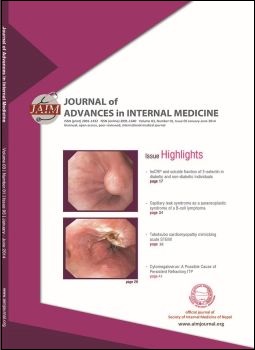Tuberculosis status among patients visiting antiretroviral therapy centers of Seti Zonal Hospital and Mahakali Zonal Hospital of far western Nepal
DOI:
https://doi.org/10.3126/jaim.v3i1.10696Keywords:
HIV, Tuberculosis, Far-western, NepalAbstract
Background and aims: Tuberculosis is still a major public health problem in Nepal. The situation is further worsened by the widespread epidemic of HIV. Knowledge of TB/HIV co-infection is essential for effective dual case management. The objective of this study was to determine the TB/HIV coinfection status among patients visiting antiretroviral therapy centers of Seti Zonal Hospital and Mahakali Zonal Hospital.
Methods: A cross sectional study was carried out in the department of Microbiology at Siddhanath Science Campus, Mahendranagar between January 2012 and July 2012. One hundred three patients were randomly selected, and were investigated for tuberculosis by direct microscopy and cultural technique. Socio-demographic features were collected by pre structured questionnaire. Data were entered into SPSS 11.5 and analyzed.
Results: Of the 103 people infected with HIV, 46 (44.7%) were males and 57(55.3%) were females. Majority (64.07%) of them were in the productive age group (21-40 years). Forty two (40.8%) of the respondents were not literate. As high as 43.9% of the women were widow and 10.7% of the studied subjects showed mother to child transmission. The overall prevalence of TB among HIV infected people was found to be 4.9%. Among five TB cases only two cases were detected by direct microscopy.
Conclusion: The overall prevalence of TB among HIV infected people was found to be 4.9%. Youths of productive age groups with low socioeconomic status were more vulnerable to HIV/AIDS. Culture was found to be more superior method of diagnosis than microscopy.
DOI: http://dx.doi.org/10.3126/jaim.v3i1.10696
Journal of Advances in Internal Medicine 2014;03(01):11-16
Downloads
Downloads
Published
How to Cite
Issue
Section
License
This license enables reusers to distribute, remix, adapt, and build upon the material in any medium or format, so long as attribution is given to the creator.




